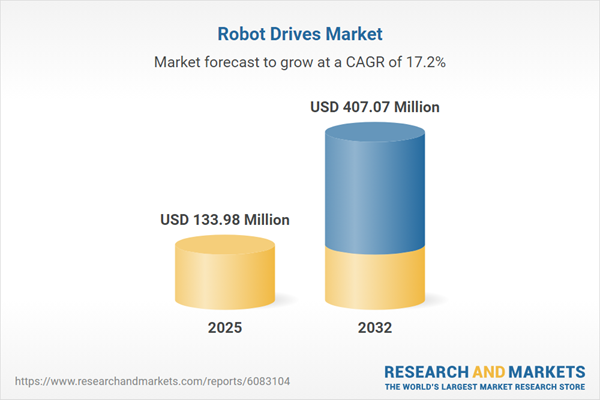Speak directly to the analyst to clarify any post sales queries you may have.
Robot drives are powering the next phase of industrial and service automation, enabling organizations to achieve new standards for productivity, consistency, and adaptive manufacturing. Senior leaders evaluating automation investments must understand core technology shifts, market catalysts, and regional adoption patterns to inform strategic choices.
Market Snapshot: Robot Drives Market Outlook
The Robot Drives Market grew from USD 114.63 million in 2024 to USD 133.98 million in 2025. Sustained by robust demand in automation, the market is projected to expand at a CAGR of 17.16%, reaching USD 407.07 million by 2032. Growth reflects rapid technological advances, integration of digital controls, and regional trends enhancing efficiency across manufacturing and service sectors.
Scope & Segmentation of the Robot Drives Market
This research delivers a complete breakdown of robot drive technologies, applications, and regional opportunities.
- Robot Types: Industrial robots such as articulated, Cartesian, delta, and SCARA configurations; service robots including personal, domestic, and professional models.
- Applications: Automotive processes like material handling, painting, and welding; electrical and electronics for inspection, PCB assembly, and semiconductor production; food and beverage packaging and sorting; healthcare tasks including laboratory and surgical automation; metal and machinery processes such as casting, molding, forging, and machining.
- Drive Types: AC servo, DC, stepper motor, and variable frequency drives tailored to distinct operational needs.
- Axis Configurations: Three, four, five, and six axis systems optimized for simple to highly complex motion control scenarios.
- Geographical Regions: Americas (sub-regions including North America and Latin America), Europe, Middle East & Africa (with key countries across Europe, the Middle East, and Africa), Asia-Pacific (including China, India, Japan, South Korea, Australia, and key Southeast Asian markets).
- Notable Companies: Yaskawa Electric Corporation, Siemens AG, Mitsubishi Electric Corporation, ABB Ltd., Rockwell Automation, Fanuc Corporation, Schneider Electric SE, Delta Electronics, Omron Corporation, and Bosch Rexroth AG.
Key Takeaways for Senior Decision-Makers
- Robot drive systems have emerged as enablers of both precise motion control and dynamic adaptation, directly supporting flexible manufacturing, service automation, and collaborative robotics initiatives.
- Technological advances—including integration of advanced motor control algorithms, sensor feedback, modular platforms, and open communication protocols—are streamlining deployment and optimizing reliability.
- Demand for drives supporting a wide spectrum of applications, from high-speed microassembly to robust operation in harsh environments, highlights the necessity for tailored solutions and scalable architectures.
- Decentralized and edge-enabled control strategies are increasingly vital, enabling localized decision-making and boosting throughput resilience—particularly in mission-critical industrial settings.
- Growing regulatory emphasis on environmental sustainability and energy efficiency is influencing design priorities, as manufacturers seek to lower power losses and conform to evolving standards.
- Strategic partnerships and innovation in drive consolidation and sourcing are giving market leaders operational agility and faster time to market.
Tariff Impact: Navigating Policy Shifts
U.S. tariff measures introduced in 2025 have altered the global cost structure of robot drive components, compelling suppliers to review sourcing strategies and expand nearshore manufacturing. This has accelerated diversification of supplier bases, collaborative capacity building, and innovation in drive packaging and design. Firms now place greater emphasis on local alternatives and integrated modules that offer both resilience and cost efficiencies across global supply chains.
Robot Drives Market: Research Methodology & Data Sources
Insights are based on thorough secondary analysis of technical papers, standards, and regulatory filings, reinforced by interviews with industry executives, engineers, and end users. Quantitative validation draws on trade statistics, manufacturer surveys, and cross-referencing with recognized industry sources. Findings were peer-reviewed by experts in robotics, supply chain, and electrical engineering, ensuring analytical rigor.
Why This Report Matters
- Delivers actionable intelligence for executive stakeholders seeking to benchmark competitors, calibrate investments, and sharpen automation roadmaps.
- Enables risk assessment and opportunity identification through detailed segmentation by technology, application sector, and region.
- Supports strategic planning by relating policy changes, innovation trends, and validated market trajectories directly to operational decision-making.
Conclusion
The Robot Drives Market is defined by innovation, adaptability, and shifting global value chains. Leaders who combine technology foresight, disciplined planning, and strategic collaboration will sustain competitive advantage through ongoing automation evolution.
Table of Contents
3. Executive Summary
4. Market Overview
7. Cumulative Impact of Artificial Intelligence 2025
Companies Mentioned
The companies profiled in this Robot Drives market report include:- Yaskawa Electric Corporation
- Siemens AG
- Mitsubishi Electric Corporation
- Rockwell Automation, Inc.
- ABB Ltd.
- Fanuc Corporation
- Schneider Electric SE
- Delta Electronics, Inc.
- Omron Corporation
- Bosch Rexroth AG
Table Information
| Report Attribute | Details |
|---|---|
| No. of Pages | 191 |
| Published | October 2025 |
| Forecast Period | 2025 - 2032 |
| Estimated Market Value ( USD | $ 133.98 Million |
| Forecasted Market Value ( USD | $ 407.07 Million |
| Compound Annual Growth Rate | 17.1% |
| Regions Covered | Global |
| No. of Companies Mentioned | 11 |









